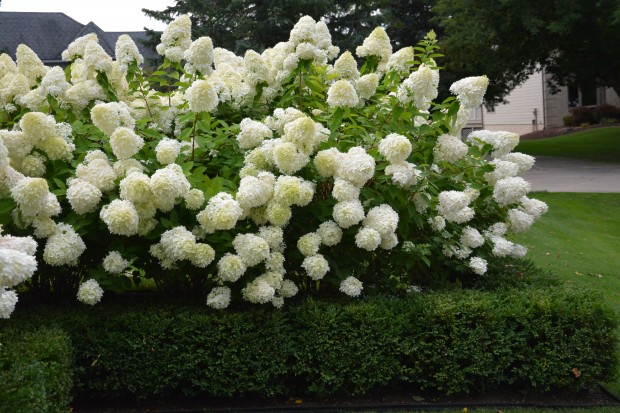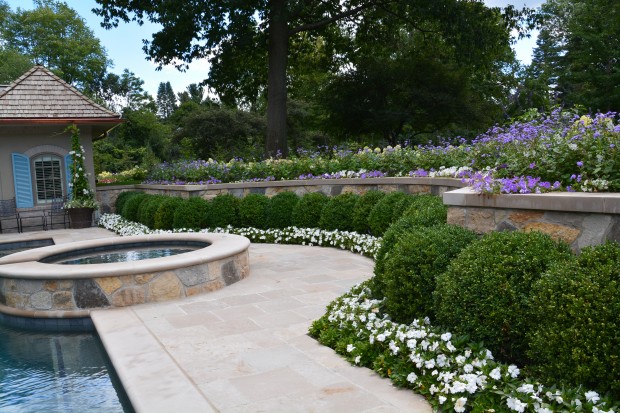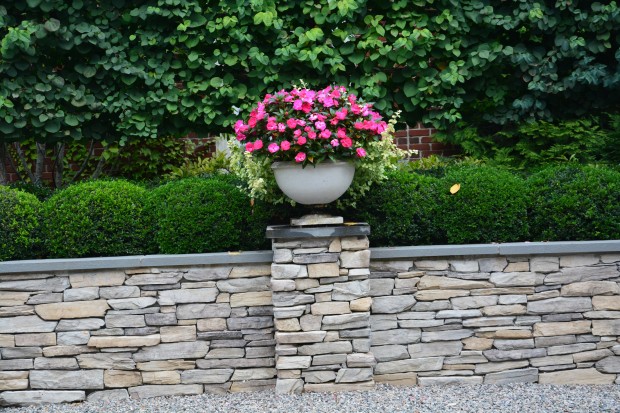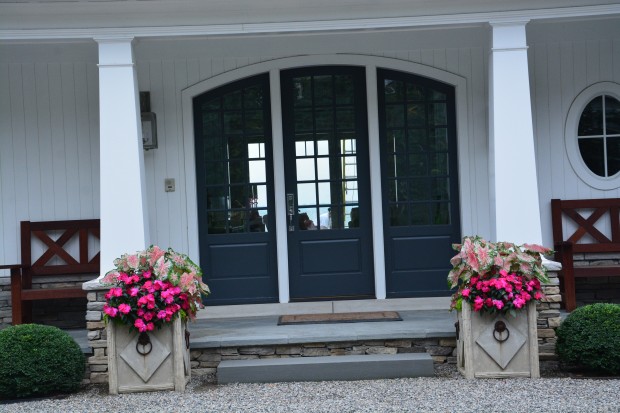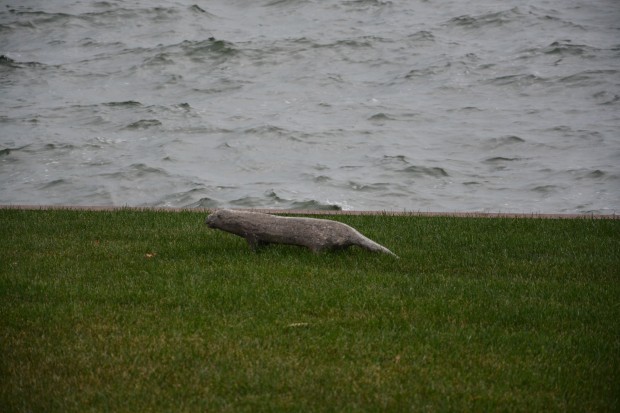 Every plant in the landscape will better realize its potential if it is kept properly pruned. A shrub that is kept pruned will respond by being densely twiggy-a strong branch structure is essential to good health. Plants that are pruned in such a way that every branch gets its fair share of light and air is a healthy plant. Every tree, shrub and perennial has its individual requirements. I prune the hydrangeas after the buds swell in late March or April. I prune out the dead wood, and branches that cross over each other. Branches that rub against each other may damage the bark – damaged bark is an invitation to insects and disease. I prune each branch individually, so every shoot has its own light and air space. The forsythias and lilacs need to be pruned right after they flower, in a very natural and loose way that mimics their natural shape.
Every plant in the landscape will better realize its potential if it is kept properly pruned. A shrub that is kept pruned will respond by being densely twiggy-a strong branch structure is essential to good health. Plants that are pruned in such a way that every branch gets its fair share of light and air is a healthy plant. Every tree, shrub and perennial has its individual requirements. I prune the hydrangeas after the buds swell in late March or April. I prune out the dead wood, and branches that cross over each other. Branches that rub against each other may damage the bark – damaged bark is an invitation to insects and disease. I prune each branch individually, so every shoot has its own light and air space. The forsythias and lilacs need to be pruned right after they flower, in a very natural and loose way that mimics their natural shape.
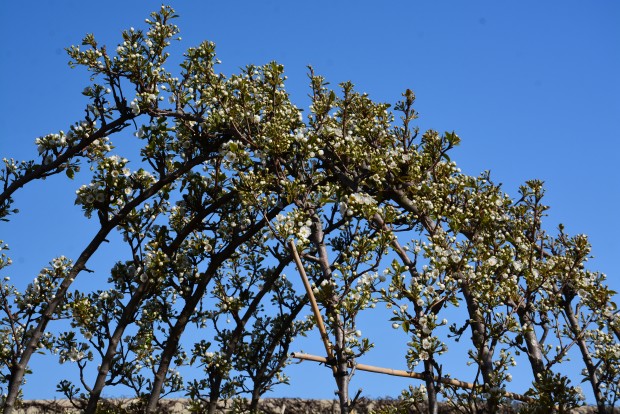 Very few plants tolerate close formal or shaped clipping. Boxwood and yews tolerate this better than other species. This results in a proliferation of growth at the ends of the branches. Eventually the light and air is excluded from the interior of the shrub. I see lots of deciduous shrubs that have been sheared, resulting in a thin layer of green at the top, and bare branches below. Those shrubs will eventually have to be hard pruned in order to renovate them, or removed altogether. It is important to keep in mind that a pruning cut is a call to grow, and will produce a reaction. The breaking of multiple new shoots is not uncommon from a single pruning cut.
Very few plants tolerate close formal or shaped clipping. Boxwood and yews tolerate this better than other species. This results in a proliferation of growth at the ends of the branches. Eventually the light and air is excluded from the interior of the shrub. I see lots of deciduous shrubs that have been sheared, resulting in a thin layer of green at the top, and bare branches below. Those shrubs will eventually have to be hard pruned in order to renovate them, or removed altogether. It is important to keep in mind that a pruning cut is a call to grow, and will produce a reaction. The breaking of multiple new shoots is not uncommon from a single pruning cut.
 Pruning to keep a shrub within the bounds of a confined space will fail sooner or later. Planting shrubs or trees that will gracefully fit a space when mature is good planning. A tree planted within 3 feet of a sidewalk is a bad idea, unless that tree is a very dwarf or grafted form. I prune most plants in the spring, although there are exceptions. I prune maples late in the summer, and grapes in the winter. The roses and clematis have their own special routine. I prune boxwood after the first flush, so I don’t have to prune again later. Pruning too late in the season is risky, and may expose a treasured plant to winter injury.
Pruning to keep a shrub within the bounds of a confined space will fail sooner or later. Planting shrubs or trees that will gracefully fit a space when mature is good planning. A tree planted within 3 feet of a sidewalk is a bad idea, unless that tree is a very dwarf or grafted form. I prune most plants in the spring, although there are exceptions. I prune maples late in the summer, and grapes in the winter. The roses and clematis have their own special routine. I prune boxwood after the first flush, so I don’t have to prune again later. Pruning too late in the season is risky, and may expose a treasured plant to winter injury.
 For those people who just love to prune, an espaliered tree is a perfect plant. Espaliers are any tree pruned to lay flat, in two dimensions, against a wall. Trees pruned in this fashion, with proper support early on, make beautiful living free standing fences. Some espaliers are pruned to assume a particular shape. They need a a sure and regular hand willing to prune. Some gardeners prune them to follow the shape of the arms, as trained. Others prune them so all of the spaces between the arms fill in with a solid structure of branches. These pairs of keiffer pear espaliers have been grown, and pruned to assume an arch shape. Once a pear arbor is purchased, we fabricate a steel arbor matching the shape of the espalier which bolts together at the top. The arms of the pear trees and tied to the steel arbor, which is installed on the underside of the trees, to maintain the shape. We were fortunate enough to obtain 8 pear arbors. All of them are gone now, and each required a little something different in terms of the steel support. An espalier pear arbor in full bloom is astonishing. It is a treasure, loaded with fruit, later in the summer.
For those people who just love to prune, an espaliered tree is a perfect plant. Espaliers are any tree pruned to lay flat, in two dimensions, against a wall. Trees pruned in this fashion, with proper support early on, make beautiful living free standing fences. Some espaliers are pruned to assume a particular shape. They need a a sure and regular hand willing to prune. Some gardeners prune them to follow the shape of the arms, as trained. Others prune them so all of the spaces between the arms fill in with a solid structure of branches. These pairs of keiffer pear espaliers have been grown, and pruned to assume an arch shape. Once a pear arbor is purchased, we fabricate a steel arbor matching the shape of the espalier which bolts together at the top. The arms of the pear trees and tied to the steel arbor, which is installed on the underside of the trees, to maintain the shape. We were fortunate enough to obtain 8 pear arbors. All of them are gone now, and each required a little something different in terms of the steel support. An espalier pear arbor in full bloom is astonishing. It is a treasure, loaded with fruit, later in the summer.
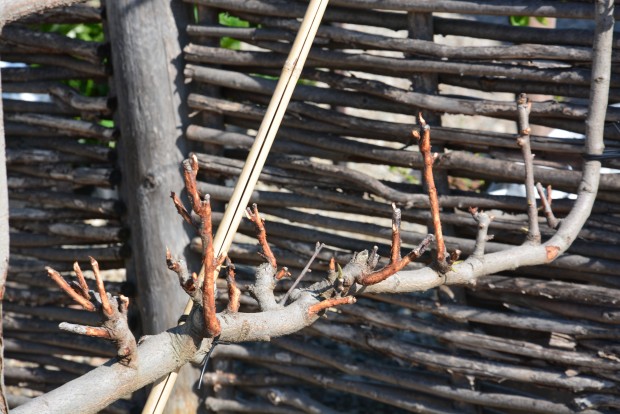 These espaliers had some pruning over this past winter that made me cringe. The lower arms had the bark chewed off the arms, and shoots were clipped off by a very sharp set of teeth. This malicious destruction of property-rabbits. Cuts to a branch on a tree or shrub at a sharp angle indicates rabbit damage. We have never had this kind of devastating damage to our espaliers over the winter before.
These espaliers had some pruning over this past winter that made me cringe. The lower arms had the bark chewed off the arms, and shoots were clipped off by a very sharp set of teeth. This malicious destruction of property-rabbits. Cuts to a branch on a tree or shrub at a sharp angle indicates rabbit damage. We have never had this kind of devastating damage to our espaliers over the winter before.
 Nature has plenty of pruning agents which may or may not be to your liking. Terrific wind storms, or ice storms can bring down dead or weak branches in trees and shrubs. Fierce weather can be an agent of pruning. Keeping trees and shrubs properly pruned is your best defense against damage from natural causes. The rabbit damage to our espalier collection was considerable. Only 12 of our trees were spared. Next fall, we plan to put up a galvanized metal fence to protect the trees.
Nature has plenty of pruning agents which may or may not be to your liking. Terrific wind storms, or ice storms can bring down dead or weak branches in trees and shrubs. Fierce weather can be an agent of pruning. Keeping trees and shrubs properly pruned is your best defense against damage from natural causes. The rabbit damage to our espalier collection was considerable. Only 12 of our trees were spared. Next fall, we plan to put up a galvanized metal fence to protect the trees.
 In the meantime, the pear trees responded to the rabbit pruning in exactly the same fashion as they have always responded to pruning. They pushed out new growth. I was astonished to see buds emerging from old thick wood-although I should not have been. The will to live is very strong. Lots of life is lurking underneath that bark. The trees responded to this severe pruning by sending forth new shoots. Should you ever fear that your pruning may damage a plant irreparably, take these pictures to heart.
In the meantime, the pear trees responded to the rabbit pruning in exactly the same fashion as they have always responded to pruning. They pushed out new growth. I was astonished to see buds emerging from old thick wood-although I should not have been. The will to live is very strong. Lots of life is lurking underneath that bark. The trees responded to this severe pruning by sending forth new shoots. Should you ever fear that your pruning may damage a plant irreparably, take these pictures to heart.
 The scars of the rabbit damage to the bark will always be there. But the bare lower branches are already beginning to re leaf.
The scars of the rabbit damage to the bark will always be there. But the bare lower branches are already beginning to re leaf.
 Plants are amazingly tolerant of bad pruning. What they don’t like is no pruning at all. The best way to learn is to read, and then do. The resulting shape and health of your shrubs will tell you if the job you have done is good, or needs a different direction. What a relief to see the new growths on these espaliers.
Plants are amazingly tolerant of bad pruning. What they don’t like is no pruning at all. The best way to learn is to read, and then do. The resulting shape and health of your shrubs will tell you if the job you have done is good, or needs a different direction. What a relief to see the new growths on these espaliers.

